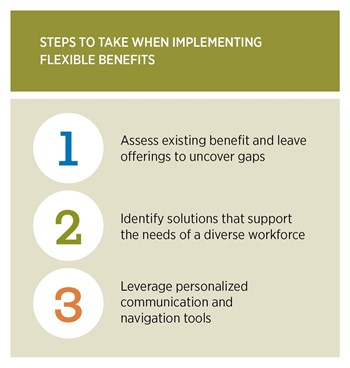
Today's workforce is truly diverse. It's made up of individuals with different backgrounds, cultures, experiences, perspectives, genders, ethnicities, ages and more. Flexible benefits can reduce an organization's risk of overlooking an employee's specific needs, helping to ensure that everyone has access to the support they want and require — now and in the future.
Flexible benefits provide employees with a highly personalized rewards experience, allowing them to select options catered to their unique wellbeing requirements and life circumstances. When done well, this approach can address previously unmet needs that have a direct impact on quality of life. It also sends a powerful signal to an increasingly diverse workforce that they're valued, and as a result, can positively impact an organization's ability to attract and retain key talent.
While the main purpose of implementing flexible benefits is to help employers stand out from their competition, flexible benefits also support wellbeing when thoughtfully designed. There can be some challenges to taking this personalized approach to employee benefits and leave programs, but employers that navigate them successfully reinforce their efforts to promote diversity, equity and inclusion, and get a significant boost to their overall people strategies.
Factors driving employers to embrace flexible benefits
Providing flexible benefits at its core isn't a new concept. However, the appearance of flexible benefits has evolved drastically from cafeteria plans to newer versions that are strikingly different — both in their reliance on more advanced technology and in their ability to provide a more tailored and relevant rewards package to meet individual's unique needs.
Today, employers can deploy more sophisticated analytics capabilities than ever before. Nearly half invest in HR technology to support their organization's people strategy, and another 41% leverage it to manage and invest in employees more strategically, according to Gallagher's 2024 US Workforce Trends Report: Organizational Wellbeing Report. The insights gained from technology help employers identify employee needs at a more granular level. Employers now also have access to a much more extensive and robust set of employee benefits to help them address those needs.
Modern life can present significant challenges for employees, especially those who work full time and have multiple personal or family obligations. Employees may have caregiving responsibilities for children or grandchildren, aging parents, or family members dealing with cancer or other serious illnesses. Yet Gallagher's 2024 US Workforce Trends Report: Physical & Emotional Wellbeing Report finds that currently few employers provide even basic resources for childcare (14%) or eldercare (15%) to help employees balance work and family life.
Particular groups of employees may have specific needs associated with their stage of life, gender, sexual orientation or other factors. Fortunately, flexible benefits related to family forming and those addressing the needs of the LGBTQ+ population are growing. Almost half of employers offer infertility services or fertility treatments, and about a quarter cover gender reassignment surgery (27%) or other transgender-inclusive benefits (25%). All three benefits are up two to three points from 2023, according to the Physical & Emotional Wellbeing Report.

In addition to providing a more extensive and targeted set of employee benefits, some employers are also offering more flexible leave programs. New and notable examples include bereavement leave for loss of pregnancy (39%), grandparent leave for birth or adoption of a new grandchild (4%) and menopause leave beyond sick time (2%).* Options like these can have a dramatic impact on employees' job satisfaction, motivation, engagement and, ultimately, loyalty.
Potential challenges for employers and employees
While budgetary constraints often influence in which employee benefits and leave programs organizations invest, ineffective communication and employee education can lead to a lack of engagement with offerings and an inability to navigate complex wellbeing ecosystems. This situation may result in a workforce that feels unsupported and programs that can't deliver on promised health outcomes or return on investment (ROI).
It's common for engagement surveys and exit interviews to reveal that members of the workforce are disappointed or frustrated at the absence of benefits to meet their specific needs that the employer does in fact already offer. That's why it's imperative to provide personalized communications in a way that's appealing and accessible, to maximize the value and appreciation of what's offered.
It's also important to strike the right balance in the number of flexible benefits provided. The key is to avoid overwhelming employees while still promoting choice and personalization. An inclusive communication strategy helps ensure employees are aware of the vast array of offerings available to them and can confidently select and use the ones that best meet their needs.
Curating a flexible benefits package that complies with various state, federal and international legislative requirements can be challenging. Lifestyle spending accounts (LSAs) — which are essentially a fixed set of funds that employees can spend on anything from gym memberships to pet sitters — are one strategy worth exploring. They reduce administrative complexity for employers while allowing them to offer more options than they could feasibly invest in on their own. For employees, LSAs may add some complexity, but they provide an opportunity to choose benefits that are personalized to their unique needs. However, since LSAs are a taxable benefit, employers should consider the potential cultural shift required and the impact on employee financial wellbeing before moving forward.
Building an action plan for implementing flexible benefits
When looking to implement flexible benefits, employers should take three steps that help ensure alignment between an employer's health and wellbeing strategy and the diverse needs of their employee population.

1. Assess existing benefit and leave offerings to uncover gaps
Employers should begin by taking an inventory of their existing benefit and leave offerings. Conducting in-depth research using quantitative data should follow. Workforce demographics help employers understand the intersecting identities and generations they're trying to support. Program effectiveness metrics — such as participation, engagement, utilization, health outcomes and ROI — can inform whether programs should be sunset or replaced with new offerings that could potentially provide more value. By linking claims data to the social determinants of health (SDOH), employers gain perspective into how the SDOH may be contributing to cost and disparities in health outcomes.
Next, insights from quantitative data should be coupled and validated with information learned through qualitative research, such as employee surveys and listening sessions. These insights can help uncover preferred communication methods, the benefits employees value and need the most, and any benefits literacy challenges. Combining and analyzing both types of research will pinpoint gaps in the flexible benefits package that need to be addressed.
2. Identify solutions that support the needs of a diverse workforce
After uncovering gaps, it's important for employers to consider alignment with their other strategic organizational priorities, emerging trends, healthcare marketplace developments, and new and pending legislation before working on solutions. With these elements in mind, they can identify flexible benefits that address gaps and deliver meaningful value to a diverse workforce.
3. Leverage personalized communication and navigation tools
Employees not only need to be aware of which flexible benefits are available to them but also understand how those flexible benefits support their specific needs. Communications should be tailored to employee preferences and serve information that's relevant and personalized to the individual. Navigation tools — such as data-driven portals, audience-specific benefit guides and personas highlighting use cases — can help ensure employees select the most appropriate offerings for their needs.
The bottom line for most employers is the importance of striking a balance in their approach to flexible benefits — providing and effectively communicating an optimal set of employee benefits and leave programs that meet the needs of a diverse workforce without overwhelming them or straining the benefits budget. When that balance is achieved, employee and organizational wellbeing flourish.




